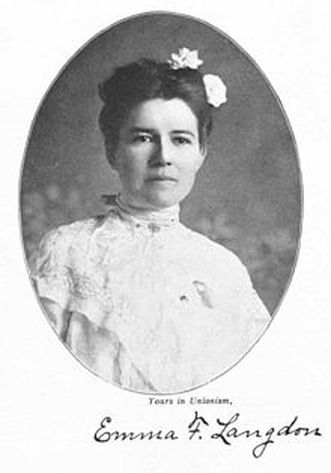Three Amazing Women You Did Not Learn About in School
 Sheriff's deputies charge women marching in support of strikers, Trinidad, CO, 1914. In writing about Fannie Sellins, I pulled an unknown heroine out of obscurity to offer today's young women a broader picture of their history.
Sheriff's deputies charge women marching in support of strikers, Trinidad, CO, 1914. In writing about Fannie Sellins, I pulled an unknown heroine out of obscurity to offer today's young women a broader picture of their history.Along the way, I uncovered similar labor union women, whose bravery has likewise been forgotten.
This week, I share some of their stories in honor of the birth day of Fannie Never Flinched, which is Tuesday, in case you missed it!
 Photo courtesy Wayne State University, Eric Margolis In this photo you see the grim faces of strikers outside a union hall in Walsenberg, Colorado after two strikers were shot dead by state police.
Photo courtesy Wayne State University, Eric Margolis In this photo you see the grim faces of strikers outside a union hall in Walsenberg, Colorado after two strikers were shot dead by state police.But you'll never see the face of the woman who took charge of the strike after all the union leaders were arrested.
She's described as a "Mexican mother", a "Indian half breed" and "Mrs. Felix Arrellano" whose husband had been injured in a mine accident.
Though her name is lost to history, The Denver Morning Post recorded her words and deeds, telling how she led a crowd of women storming the jail, demanding to see their husbands and sons who'd been locked up, or transported across the state line under threat of death if they returned.
"If we were asking for diamonds we wouldn't deserve them," this nameless woman began her fiery speech."But we are asking for bread."
 Half a dozen strikers were shot dead and scores wounded before mine owners finally gave in and settled the strike, though they refused to recognize the union.
Half a dozen strikers were shot dead and scores wounded before mine owners finally gave in and settled the strike, though they refused to recognize the union. Another labor union heroine is Emma Langdon, and we know her name because she set linotype at a union newspaper in the gold mining district of Cripple Creek, Colorado.
During the Cripple Creek Strike in 1904, national guard troops arrested the staff of the Victor Daily Record. But they overlooked Emma, maybe because she was a woman.
She sneaked into the newspaper office and working through the night,
published the next morning's edition.
Another brave woman tried to stop the violence of one of the bloodiest attacks in American Labor history.
On Memorial day, 1937, a steelworkers strike turned deadly in southeast Chicago. Police opened fire on a crowd of men, women and children marching toward the front gate of Republic Steel. Ten workers were shot dead and thirty wounded.
Lupe Marshall, a housewife and social worker was one of another fifty-five union sympathizers beaten in the melee of police clubs, tear gas and bullets.
 During and investigation by the U.S. Senate Committee on Education and Labor, Lupe described what happened that day.
During and investigation by the U.S. Senate Committee on Education and Labor, Lupe described what happened that day.I evaded these policemen that were immediately in front of me . . . . I was aware that my head was bleeding. I noticed that my blouse was all stained with blood, and that sort of brought me to, and I started walking slowly toward the direction from which a policeman had just clubbed an individual, and this individual dragged himself a bit and tried to get up, when the policeman clubbed him again. He did that four times.... I screamed at the policeman and said, “Don’t do that. Can’t you see he is terribly injured?” And at the moment I said that, somebody struck me from the back again and knocked me down.
 Memorial Day, 1937, Republic Steel Strike, photo courtesty http://memorialdaymassacre.weebly.com/thesis.html
Memorial Day, 1937, Republic Steel Strike, photo courtesty http://memorialdaymassacre.weebly.com/thesis.html Before Lupe and other victims received medical help, one man died, his head in her lap. As often happened when strikes turned violent, police claimed they acted in self-defense and blamed the violence on communists and radicals.
Some fifteen years later during the McCarthy era, Lupe Marshall was charged with communism and faced deportation under the McCarran-Walter Act of 1952. There is no evidence that she had done anything illegal or was a threat to national security, but she moved to Jamaica and never returned to the U.S.
Published on October 30, 2016 10:48
No comments have been added yet.



